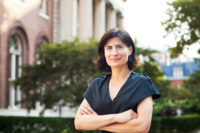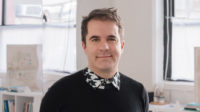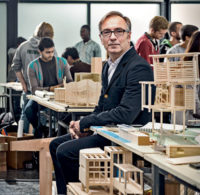Andraos, whose father practiced architecture, was born in Beirut, Lebanon, and has lived in Saudia Arabia, France, Canada, and Holland. She attended McGill University before receiving her M.Arch. from the Harvard Graduate School of Design, later working for the Office for Metropolitan Architecture in Rotterdam. Andraos founded the New York–based WORK Architecture Company (WORKac) with Dan Wood in 2003. Though she has taught in a number of architecture schools throughout the northeastern United States, she is still a relatively young practitioner—age 41—with a modest body of work. record recently spoke with Andraos about the current direction of the school and of the architectural discipline.
Aleksandr Bierig: There’s been some sense that you are the first dean from a “new generation” of architects. Do you see yourself in that light?
Amale Andraos: I do feel part of a network of architects working globally, who encounter similar struggles and find similar ways to deal with them. I also feel very strongly that we are a kind of poststarchitect generation, interested in architecture and social engagement and environmental concerns. Practices are more collaborative, and hybrid models involving various disciplines are emerging.
How could Columbia promote these new ways of working?
Something unique about GSAPP is that we don’t have a single definition of “practice.” We have people like David Benjamin, who moves between the digital and the material worlds, or Laura Kurgan, who is defining another model through data visualization, or Kate Orff, who has pioneered thinking between urbanism and ecology. And there is Hilary Sample, whose work is very architectural but at the same time engaged with questions of public health. In my case, WORKac started researching food, and now we’re building the Edible Schoolyard in Brooklyn. This is not an either/or condition, where either you do architecture or you are socially engaged. You can find ways to do both.
There are also negative effects of global practice—for example, how it often reinforces economic or ecological inequalities. Is Columbia a place for conversation about these issues?
Columbia should certainly lead the discussion. In October, I cohosted a symposium, “Architecture and Representation: The Arab City,” that addressed questions of cultural representation and the reductive nature of what is often produced in this kind of global practice. Intense collaboration among architects who are working in a particular place allows us to understand these contexts, but there are also issues that are not specific to place. If you are concerned with ecology and environment, or with issues of equity, you’ll find that the dynamics of globalization are producing similar conditions around the world.
Are there things you’d like to change in the coming years at Columbia?
I’m obsessed with architectural models. Students today can sometimes show too much reliance on heavy technology—I don’t think you need to make a cube with a 3-D printer. I want to bring back the culture of physically making things. Are you suspicious of some of the technological tools available? No, not suspicious. It’s about choice. If you’re simply waiting for your laser-cut file, you’re not in control. GSAPP has a great legacy of working with a lighter, softer infrastructure rather than a heavy, weighty type—one thinks of [former dean] Bernard Tschumi’s paperless studio, or [former dean] Mark Wigley’s interest in networks. We need to have agility to move across different platforms.
How do you balance that agility with discussion of structural issues that are difficult to change? Is the school a place for utopian thinking? For design ideas based on imagining new societal structures?
A school should engage the world as it is, with a high optimism in its ability to change it. I would say that we now realize that working with the real is as utopian as anything else. But utopian is such a loaded word. Students are creative, critical, entrepreneurial, strategic. But I wouldn’t see the school as utopian.
Do you think that position is partly a result of the conditions under which you’ve practiced over the past 20 years?
I don’t see my practice as the same as the school. I think they’re very separate, and in my practice we have had an interest in visionary urbanism and its agency. But the goal is to work with the real and be utopian at the same time, with a kind of stubborn insistence that we can engage the real. But it’s not an unconditional engagement. It’s not “yes to everything.” It’s a very conditional engagement, but it’s an engagement nevertheless.
Aleksandr Bierig is a Ph.D. student at Harvard’s Graduate School of Design and a former editorial assistant at RECORD. His writing has appeared in RECORD, Architectural Review, Log, Clog, and Pidgin.







Post a comment to this article
Report Abusive Comment